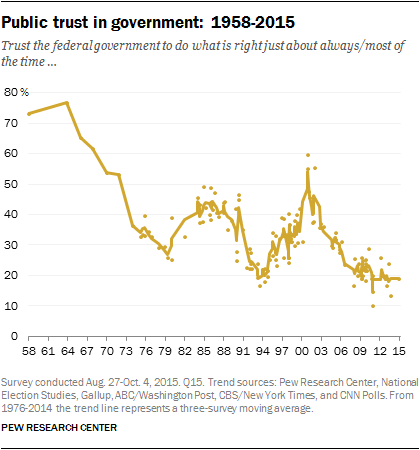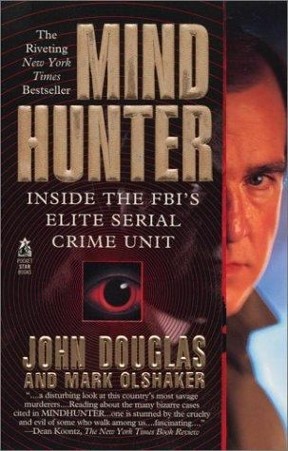John Douglas understands evil.
He’s seen things that most of us can barely imagine.
His story is a fascinating one.
Douglas first joined the Federal Bureau of Investigation in 1970, where he occupied a range of roles — going from SWAT member to hostage negotiator to criminal psychologist.
It was at the FBI’s Behavioral Science Unit that he found his life’s calling.
The ‘70s was a turbulent time for America — and Douglas had a front-row seat as he watched the nation being pushed to the edge.
Several pivotal events happened:
- The Watergate scandal.
- The Church Committee revelations.
- The OPEC oil crisis.
- The end of the Vietnam War.
- The surge of civil unrest.
All of this came together to form an ugly cocktail that saw public trust in government plunge sharply.
By the end of the ‘70s, the Pew Research Center reveals that only about a quarter of Americans felt that they could trust their government at least most of the time.

A disturbing era
This period of social anxiety also coincided with the rise of a new kind of criminal — the serial killer.
According to Douglas’ book Mindhunter: Inside the FBI’s Elite Serial Crime Unit, police departments across America were initially confused and even terrified by this emerging phenomenon.

Source: Chegg
They were more used to catching criminals with clear-cut motives like greed or jealousy.
For example, a perpetrator would rob a bank because he wanted money. Or a perpetrator would murder his spouse because he discovered she had been cheating on him.
But the serial killer seemed to defy all explanation. He was an apex predator. The ultimate bogeyman. He would stalk and slaughter victims that he seemingly had no connection to, then melt away like a ghost, leaving few clues behind.
As a string of gruesome killings paralysed the country, John Douglas hit the road. He moved across the American heartland, interviewing both cops and criminals to gain a better understanding of why this was happening.
Among the imprisoned perpetrators he interviewed:
- David Berkowitz.
- Ted Bundy.
- John Wayne Gacy.
- Charles Manson.
- Edmund Kemper.
Soon enough, Douglas recognised that the old way of catching violent perpetrators was outdated — and a new scientific method was urgently needed.
This was the birth of criminal profiling.
Douglas believed that serial killers were emerging not just because of overt changes happening in the social landscape, but also the subconscious impulses that were being triggered within the minds of the killers themselves.
So, to catch them, you have to put yourself in their shoes. This means carrying out an in-depth analysis of their behaviour and habits, as well as reconstructing their background and childhood.
From the start, Douglas’ theories seemed too radical, too zealous.
He faced resistance from his colleagues, who preferred to stick to more old-fashioned procedures. But Douglas was determined to explore and expand his methods. So he pushed through the bureaucratic red tape, fighting for the resources he needed.
Slowly, surely, criminal profiling began to gain credibility and produce results. And law enforcement across America began to get better at identifying and catching serial killers.
Now, here’s an interesting fact: the Golden Age of Serial Murder, as coined by historian Harold Schechter, stretched from 1970 to 2000.
But from 2000 onward, serial killers appear to have almost entirely vanished.
Why?
This may be due, in large part, to John Douglas’ pioneering work. He has brought criminal profiling into the mainstream, making it harder for serial killers to operate undetected.
You also can’t overlook the fact that a booming economy and more social stability in the 21st century have erased some of the issues that gave birth to serial killers in the first place.
However, profilers in law enforcement can’t rest on their laurels. We may actually be one seismic event (or two) away from the next serial-killer cycle.
It’s important to be vigilant and prepared.
Lessons for investors
John Douglas had conviction in his methods. And he had the courage to act on it.
So, as an investor, here are the critical lessons you need to consider as you map out your own blueprint for success:
- Be willing to revisit your assumptions.
- Be willing to adapt your methods.
- Be willing to push through with conviction.
At the moment, are you using scientific methods to ‘profile’ the stocks you’re investing in? Do you understand what’s happening on the surface, as well as what’s happening below? Do you know why?
In our Quantum Wealth Report, we are currently exploring global opportunities in property, infrastructure, energy, technology, and so much more.
It’s about giving you the best financial profiling — so you can find the inspiration to be robust and well-rounded.
Life is about cycles.
Will you catch the next wave?
Regards,
John Ling
Analyst, Wealth Morning





John is the Chief Investment Officer at Wealth Morning. His responsibilities include trading, client service, and compliance. He is an experienced investor and portfolio manager, trading both on his own account and assisting with high net-worth clients. In addition to contributing financial and geopolitical articles to this site, John is a bestselling author in his own right. His international thrillers have appeared on the USA Today and Amazon bestseller lists.